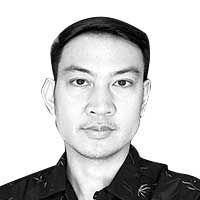Ed Castrillo: Maker of monuments and moments

Public monuments — the best there are — are so intertwined with their environments that the latter would be unthinkable without the former. In the country, no other artist has revolutionized the realm of monuments more than Eduardo “Ed” Castrillo who marked many a place with his metallic sculptures soaring towards a notion of a collective self or spiritual redemption. He passed away last May 18, leaving behind a formidable body of work spanning more than four decades. He was 73 years old.
Through what he called as his “Cultural Legacy Series,” Castrillo produced what must be some of the most viewed works by a Filipino artist: the People Power Monument along EDSA, the Bonifacio and the Katipunan Revolution near Manila City Hall, and the “Redemption” at Metrobank Plaza in Makati City, among many others. For his contributions, he was awarded the Araw ng Maynila Centennial Award and the Republic Cultural Heritage Award.
While he was the natural heir to the grand tradition of sculpture begun by National Artists Guillermo Tolentino and Napoleon Abueva, Castrillo did not pay heed to what was conventional and accepted. The start of his artistic foray was atypical at best: after taking up a Fine Arts degree at the University of Santo Tomas, he started his career as jewelry designer for the famed Estrella del Norte. The owner, Levy Hermanos, was so impressed with the young Castrillo when he produced seven studies, in full color, within 20 minutes, that he hired him on the spot.
From then on, Castrillo established himself as an avant-garde artist, exploring the possibilities of a wide variety of materials that included plexiglass, neon light, ivory, and wood. Sculpture, which was hardly untouched by the modernism in painting, was energized by the innovations of Castrillo who brought to his works a more contemporary feel. The artist himself was a man of his times, sporting the most fashionable of clothes and wearing with aplomb mismatched sneakers.
“Castrillo has always stood apart from the mundane and conventional, be it in material, process or themes,” said Jeannie Javelosa, writer and artist. “His choice has always been that which is the more challenging, the more difficult. His humanistic, spiritual and philosophical themes explore the deepest human aspirations, angst and renewal.”
Art critic Cid Reyes, on the other hand, remarked on the artist’s “energy of great ambition. Not in the careerist sense but in grandeur of vision — and result. Vision alone, without the requisite willpower, remains just that: a vague, amorphous yearning. But because it is in the character of Castrillo to attack a challenge head-on, and more importantly, on his own terms, he has achieved what no other sculptor has done.”
“Walang imposible sa kanya,” affirmed fellow sculptor Ral Arrogante. “Yung boldness niya yung nagdala sa kanya…Di niya kailangang lumaban sa mga old masters. Pati yung mga welding niya na odd shapes, mga abstract shapes, they always attract people who want something new.”
Aside from historical monuments, Castrillo also produced environmental art, free-standing abstract pieces, functional art pierces, art jewelry and body sculptures, and liturgical arts. His works are remarkable for their angular forms, the dynamism of the figures, the balance between mass and space, as well as the innovative fabrications of metal.
In his website, Castrillo stated that his main attraction to sculpture is its “physicality…the heavy duty labor that goes into it and the challenges of taming the material, controlling the tough solidity of the medium and moulding it into something flesh-like, life-like.”
He likened the creative experience to “something like a gladiator in an arena, where he faces the opponent with a sense of trepidation, knowing that the opponent will not surrender without a fight. The challenge is there. And it is great. Then again, there is something beyond the ‘physical combat’ with the medium. The challenge assumes metaphysical proportions. A man must first challenge himself to the limits of his being, his talent, his spirit and triumph over the most formidable of odds.”
Despite his towering presence in the art world, Arrogante said that Castrillo was never standoffish. “Magaling siyang makisama. Galante yan. Halimbawa, sasabihin niya na ite-treat ko na yung buong grup ng pagkain. Sometimes, nagdo-donate siya ng artworks para ma-i-raise yung pondo.”
The main beneficiaries of his kindness were his many nephews and nieces who called him not only an uncle but “father,” “mentor,” “friend,” “amo,” “big brother,” and “best buddy sa sabong.”
“He was a great man with admirable vision,” said Monna Castrillo-Seares. “We will be forever thankful for the opportunities he opened for us, for his generosity and his unquestionable care.”
* * *
The wake of Eduardo “Ed” Castrillo is held in his studio at 899 Molino National Road, Bacoor Cavite until today. Internment is set the following day.



















